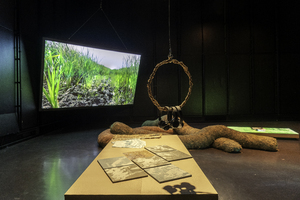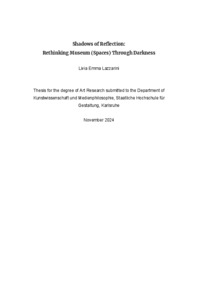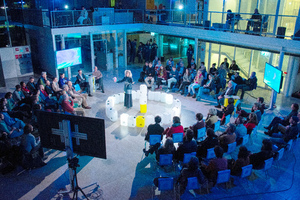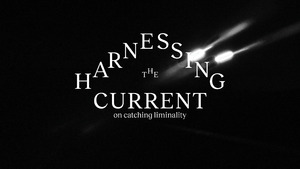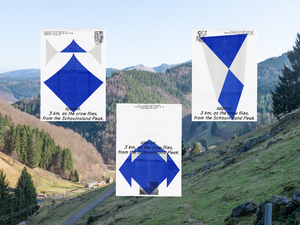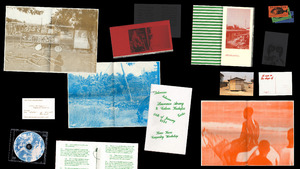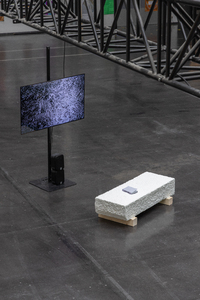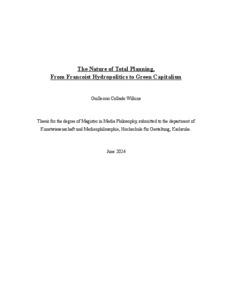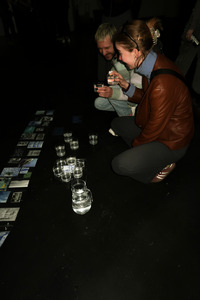"EN"
| Begriff | EN |
| Metakey | Sprache (creative_work:language) |
| Typ | Keyword |
| Vokabular | Werk |
50 Inhalte
- Seite 1 von 5
TOWER POWER
- Titel
- TOWER POWER
- Autor/in
- Beschreibung (de)
- TOWER POWER ist eine performative Untersuchung der architektonischen Formensprache und Symbolik des Torre Fiat in Marina di Massa, Italien - dem Ausstellungsort des POST-COLONIA Festival of Architecture and Imaginaries in Transition.
Als in Architektur materialisierte Ideologie steht der Turm scheinbar unausweichlich für eine lineare, gewaltvolle Erzählung von Geschichte. Mithilfe von Ursula K. Le Guins „Carrier Bag Theory of Fiction“ (1986) befragt TOWER POWER die dem Turm eingeschriebenen Narrative und den Umgang mit einem derart aufgeladenen baulichen Erbe.
- TOWER POWER ist eine performative Untersuchung der architektonischen Formensprache und Symbolik des Torre Fiat in Marina di Massa, Italien - dem Ausstellungsort des POST-COLONIA Festival of Architecture and Imaginaries in Transition.
- Beschreibung (en)
- TOWER POWER is a performative investigation of the formal language and architectural symbolism of the Torre Fiat in Marina di Massa, Italy - the venue of POST-COLONIA Festival of Architecture and Imaginaries in Transition we had been invited to explore and exhibit in.
Steeped in ideology, the tower’s architecture inescapably seems to stand for a linear, violent historiography. TOWER POWER investigates the narratives inscribed into the tower through the lens of Ursula K. Le Guin’s Carrier Bag Theory of Fiction and poses questions on how to deal with such a charged architectural legacy.
- TOWER POWER is a performative investigation of the formal language and architectural symbolism of the Torre Fiat in Marina di Massa, Italy - the venue of POST-COLONIA Festival of Architecture and Imaginaries in Transition we had been invited to explore and exhibit in.
- Kategorie
- Typ des Projekts/Werks
- Datierung
- 2025
- Mitwirkende
- Dank an
- Sprache
- Dauer
- 12 Minuten
- Titel
- TOWER POWER
- Importiert am
- 27.06.2025
- Übergeordnete Sets
- 0
- Set enthält
- 0 0
Big Hat Big Problems
- Titel
- Big Hat Big Problems
- Titel (en)
- Big Hat Big Problems
- Untertitel
- A salonesque affair hosted by Filler Verlag
- Untertitel des Projekts/Werks (en)
- A salonesque affair hosted by Filler Verlag
- Autor/in
- Beschreibung (de)
- Filler Verlag ist eine unabhängige Plattform für das Buch und für den Diskurs, der aus ihm hervorgeht. „Verlegen“ wird dabei nicht als Akt der Verteilung, sondern als ein Akt des Teilens verstanden. Der Fokus liegt auf der kollektiven Entwicklung und dem Fördern von Diskurs. Mit diesem experimentellen Ansatz denkt Filler das Buch weiter: Wie kann es als Medium in einer zunehmend digitalen und schnelllebigen Welt relevant bleiben? Welche Rolle spielen unabhängige Verlage in einer Zeit, in der Massenproduktion und Standardisierung dominieren?
Aus diesen Fragen heraus entstand Big Hat Big Problems – eine Reihe von Zusammenkünften. Sowohl im physischen als auch im metaphorischen Sinne ist Big Hat Big Problems ein Ort der ständigen Verhandlung und des Austauschs, aber auch des Verweilens. In der Struktur gibt es Referenzen zu literarischen Salons. Lesungen, Gespräche, dicke Teppiche, gemütliche Sessel und gedimmtes Licht. Ein entscheidender Unterschied: Die Gästeliste ist nicht exklusiv.
Big Hat Big Problems ist eine Einladung, das Buch nicht wie üblich als ersten Schritt des Veröffentlichens zu begreifen, sondern als Mittel, um Öffentlichkeiten zu schaffen. An diesen Öffentlichkeiten bedient sich Filler, denn aus jedem Treffen sollen Nachträge der Beitragenden, aber auch Einfälle oder offene Fragen der Teilnehmenden hervorgehen und festgehalten werden. Diese sollen das anfängliche Skript und somit den Inhalt des Buches fortschreiben. Als Gegenthese zum traditionellen Austellungskatalog, der ein Projekt abschließt, wird der Katalog zu Big Hat Big Problems durch jede Veranstaltung erweitert. Er ist modular, jede Zusammenkunft ein Kapitel.
Das Programm ist nicht thematisch gegliedert, Schwerpunkt liegt auf ephemeren Aspekten. Die Fokussierung auf einen Abend – dass alles nur einmal zu hören oder zu sehen ist –
lenkt die Kuration. Den Großteil der Beiträge machen gelesene Texte aus, auch die Aufnahme eines Hörspiels wird nur einmal abgespielt. Die Straße vor dem Ausstellungsraum wird auch durch eine große Kreidezeichnung bespielt. Der Salon öffnet sich; veröffentlicht sich. Im Grunde ist das schon Kunst im öffentlichen Raum, am nächsten Tag aber wieder weg. Das Programm hat keinen Zeitplan, nur eine Reihenfolge und im Laufe des Abends kommt es zu zufälligen Begegnungen und ungeplanten Beziehungen zwischen den Texten. Und innerhalb des Publikums auch, dass à la Salon in den Pausen zwischen den Interventionen über das Erfahrene diskutiert. Big Hat Big Problems will zeigen, dass jede Bewegung und jedes Verstehen nur im Bezug auf andere und ihre Worte möglich ist – auch das Verstehen der eigenen Position, der eigenen Arbeitsweisen und ihrer Wirkung. Kunst, die uns oder etwas berührt, entsteht stets im Dialog mit den Ideen anderer.
Es bleibt Raum für Zweifel, für unvollendete Gedanken und ein Glas zwischendurch. Es gibt keine Botschaften zu entschlüsseln – nur die Einladung, Mehrdeutigkeiten zu akzeptieren.
- Filler Verlag ist eine unabhängige Plattform für das Buch und für den Diskurs, der aus ihm hervorgeht. „Verlegen“ wird dabei nicht als Akt der Verteilung, sondern als ein Akt des Teilens verstanden. Der Fokus liegt auf der kollektiven Entwicklung und dem Fördern von Diskurs. Mit diesem experimentellen Ansatz denkt Filler das Buch weiter: Wie kann es als Medium in einer zunehmend digitalen und schnelllebigen Welt relevant bleiben? Welche Rolle spielen unabhängige Verlage in einer Zeit, in der Massenproduktion und Standardisierung dominieren?
- Beschreibung (en)
- Filler Verlag is an independent platform for the book and for the discourse that emerges from it. “Publishing” is not understood as an act of distribution, but as an act of sharing. The focus is on collective development and the promotion of discourse. With this experimental approach, Filler thinks the book further: How can it remain relevant as a medium in an increasingly digital and fast-moving world? What role do independent publishers play in an age dominated by mass production and standardization? these questions gave rise to Big Hat Big Problems - a series of gatherings. In both a physical and metaphorical sense, Big Hat Big Problems is a place of constant negotiation and exchange, but also of dwelling. There are references to literary salons in the structure. Readings, conversations, thick carpets, cozy armchairs and dimmed lights. One decisive difference: the guest list is not exclusive.Big Hat Big Problems is an invitation to see the book not as the first step towards publication, as is usually the case, but as a means of creating publics. Filler makes use of these publics, as each meeting is intended to produce and record additions from the contributors, as well as ideas or open questions from the participants. These are intended to continue the initial script and thus the content of the book. As an antithesis to the traditional exhibition catalog that concludes a project, the catalog for Big Hat Big Problems is expanded through each event. It is modular, each meeting is a chapter, the program is not thematically structured, the focus is on ephemeral aspects. The focus on the single evening - that everything can only be heard or seen once - guides the curation. The majority of the contributions consist of read texts, even the recording of a audio play is only played once. The street in front of the exhibition space is covered by a large chalk drawing. The salon opens up; publishes itself. Basically, this is already art in public space, but it's gone again the next day. The program has no schedule, only a sequence, and in the course of the evening there are chance encounters and unplanned relationships between the texts. And within the audience, too, that à la Salon discusses what they have experienced in the breaks between the performances. Big Hat Big Problems wants to show that every movement and every understanding is only possible in relation to others and their words - including the understanding of one's own position, one's own working methods and their effect. Art that touches us or something is always created in dialog with the ideas of others. There is room for doubt, for unfinished thoughts and a glass in between. There are no messages to decipher - only the invitation to accept ambiguity.
- Kategorie
- Typ des Projekts/Werks
- Schlagworte
- Datierung
- 3./15. Juli 2025, fortlaufend
- Mitwirkende
- Sprache
- Material
- Dauer
- 2 Abende
- Ort: Institution
- Stadt
- Land
- Titel
- Big Hat Big Problems
- Importiert am
- 27.06.2025
- Übergeordnete Sets
- 0
- Set enthält
- 0 0
"Wet again"
- Titel
- "Wet again"
- Untertitel
- Wahrnehmung und Abstraktion von Erhaltungsarbeit im ländlichen Raum
- Untertitel des Projekts/Werks (en)
- Perception and abstraction of maintenance work in the rural
- Autor/in
- Beschreibung (de)
- „Wet again“ ist das Ergebnis eines zweijährigen Prozess von Laura Haak, eine Moorregion als Akteur
wahrzunehmen und zu begleiten. In einem abgelegenen Terrain im Nordosten Deutschlands nahe dem
Kummerower See im Malchiner Umland liegt. In einer Feldforschung wurde viel Zeit verbracht, Scores der Zusammenarbeit entwickelt, Wander und Kanu Routen 1:1 erschlossen. Dabei entstand ein Austausch mit den Menschen vor Ort, die eine längere Beziehung zum Torfboden pflegen und sich für die Wiedervernässung von Moorböden lokal und europaweit einsetzen.
Es entstand ein Gewebe aus verschiedenen Wahrnehmungsperspektiven und die Frage nach ihren machtpolitischen Auswirkungen auf ländliche Gestaltungsprozesse.Was sind die neuen Choreografien der Erhaltungsarbeit, auf welche Perspektiven wird Bezug genommen?
Auf mehreren Testfeldern der Universität Greifswald und des Greifswald Moor Instituts werden aktuell Daten gesammelt, die zu einer Umstellung der europäischen Subventionierung von Moorkulturen genutzt werden. Lokale Archivmaterialien über einen Hexenprozess, hochstaplerische Ritterbrüder aus Lüneburg und DDR Fdj Jugendcamps für staatliche Meliorationsvorhaben geben Einblick in die historische Dimensionen.
Lokale Künstler und Umweltwissenschaftler schaffen Austauschorte für ökologisch bezogene Kulturarbeit.
Landwirte die mit den sehr existenziellen Fragen der direkten Übersetzung der Ideen konfrontiert sind,-und über 5000 Jahre intakte Bodenproben die als eigenes Archiv eine noch viel längere viel größere Geschichte zu erzählen haben.
Eindrücke und Materialien dieser Zeit verarbeitet Laura Haak in einer Installation aus 4 unterschiedlich langen Videoessays mit immersiver Soundcollage, bedruckten lokal hergestellten Grasfaserplatten, einer Projektionsfläche aus Agaragar und Paludikulturen und einer Sitzinstallation aus 130kg Seggenrohrgras
der vor Ort gefilmten Felder.
Ein Reader mit gesammelten Materialien und textlichen Einordnungen inspiriert von Essays von Tim Ingold schlägt eine Dramaturgie vor, die im Sinne der eigenen Wahrnehmung verworfen werden kann.
- „Wet again“ ist das Ergebnis eines zweijährigen Prozess von Laura Haak, eine Moorregion als Akteur
- Beschreibung (en)
- ‘Wet again’ is the result of a two-year process by Laura Haak to perceive and accompany a moorland region as an acting entity.
It is located in a remote area in north-eastern Germany near Lake Kummerow in the Surrounding Malchin.
A lot of time was spent conducting field research, developing scores of collaboration, and tracing hiking and canoe routes 1:1.
This led to an exchange with local people who have a long-standing relationship with the peat soil and are committed to the rewetting of moorland soils both locally and across Europe.
A fabric of different perspectives emerged, along with questions about their power-political implications for rural design processes. What are the new choreographies of maintenance work, and what perspectives are being referred to?
Data is currently being collected at several test sites at the University of Greifswald and the Greifswald Moor Institute, which will be used to change European subsidies for moorland cultivation. Local archive materials about a witch trial, impostor knights from Lüneburg and GDR Fdj youth camps for national drainage projects provide insight into the historical dimensions.
Local artists and environmental scientists are creating places of exchange for ecologically-related cultural work.
Farmers who are confronted with the very existential questions of directly translating ideas,- And over 5,000 years intact soil samples that, as an archive in their own, have an even longer and much greater story to tell.
Laura Haak processes impressions and materials from this period in an installation consisting of four video essays of varying lengths with an immersive sound collage, printed locally produced grass fibre boards, a projection surface made of agar agar and paludicultures, and a seating installation made of 130 kg of sedge grass
from the fields filmed on site.
A reader with collected materials and textual classifications inspired by essays by Tim Ingold suggests a dramaturgy that can be discarded in the sense of one's own perception.
- ‘Wet again’ is the result of a two-year process by Laura Haak to perceive and accompany a moorland region as an acting entity.
- Kategorie
- Typ des Projekts/Werks
- Schlagworte
- Datierung
- Zwei Sommer und ein Frühjahr 2023-2025
- Sprache
- Titel
- "Wet again"
- Projektleiter/in
- Studiengang
- Typ der Abschlussarbeit
- Importiert am
- 30.06.2025
- Übergeordnete Sets
- 0
- Set enthält
- 1 3
Shadows of Reflection: Rethinking Museum (Spaces) Through Darkness
- Titel
- Shadows of Reflection: Rethinking Museum (Spaces) Through Darkness
- Autor/in
- Beschreibung (de)
- In zeitgenössischen Museen können hell erleuchtete Räume - die so genannten „White Boxes“ - im Zusammenspiel mit Kunstwerken, die Szenen von Gewalt und Diskriminierung darstellen, befremdlich wirken. Auch wenn es wichtig ist, historische Ereignisse aufzuarbeiten und Minderheitengruppen sichtbar zu machen, kann der Kontrast zwischen der hellen Umgebung, dem behandelten Sachverhalt und der Realität selbst in diesen Kontexten zu einer Entfremdung führen.
Diese Magisterarbeit untersucht das Spannungsverhältnis zwischen hell erleuchteten Museumsräumen und der Darstellung schwieriger politischer Themen und schlägt dunkle Umgebungen als Gegennarrative vor. Keller, Bunker und Dunkelkammern können in diesem Sinne Erlösungsräume sein, die Platz für die Neudefinition von Machtstrukturen, für Freiheit und Emotionen lassen. Ein dunkler Raum ermöglicht somit transformative Erfahrungen, bei denen der Blick negiert und das Gefühl von Verletzlichkeit spürbar wird , was zu Überlegungen darüber einlädt, wie eine eingeschränkte Sichtbarkeit paradoxerweise unsere Fähigkeit, in einem umfassenderen, emotionaleren und bewussteren Sinne zu „sehen“, verstärken könnte. Dies wirft folgende Frage auf: Kann Dunkelheit emotionale Nähe fördern und neue Sichtweisen unterstützen?
- In zeitgenössischen Museen können hell erleuchtete Räume - die so genannten „White Boxes“ - im Zusammenspiel mit Kunstwerken, die Szenen von Gewalt und Diskriminierung darstellen, befremdlich wirken. Auch wenn es wichtig ist, historische Ereignisse aufzuarbeiten und Minderheitengruppen sichtbar zu machen, kann der Kontrast zwischen der hellen Umgebung, dem behandelten Sachverhalt und der Realität selbst in diesen Kontexten zu einer Entfremdung führen.
- Beschreibung (en)
- In contemporary museum spaces, the prevalence of brightly lit spaces – the so-called “white-boxes” – can be jarring when juxtaposed with artworks representing scenes of violence and discrimination. While it is essential to process historical events and give visibility to minority groups, in these contexts, the contrast between the bright environment, the subject matter and reality itself can create a disconnect.
This dissertation explores the tension between brightly lit museum spaces and their representation of challenging political subjects, proposing dark environments as a counter-narrative. Basements, bunkers and darkrooms, in this sense, can be redemption spaces that leave room for redefining power structures, for freedom and emotions. A dark space is thus a fundamental way of facilitating transformative experiences, where the gaze is negated and we all feel vulnerable, inviting considerations of how limited visibility might paradoxically enhance our ability to "see" in a broader, more emotionally and intentional engaged sense – raising the question: can darkness foster emotional proximity and encourage new ways of seeing?
- In contemporary museum spaces, the prevalence of brightly lit spaces – the so-called “white-boxes” – can be jarring when juxtaposed with artworks representing scenes of violence and discrimination. While it is essential to process historical events and give visibility to minority groups, in these contexts, the contrast between the bright environment, the subject matter and reality itself can create a disconnect.
- Kategorie
- Schlagworte
- Datierung
- 26.12.2024
- Sprache
- Titel
- Shadows of Reflection: Rethinking Museum (Spaces) Through Darkness
- Projektleiter/in
- Semester
- Studiengang
- Typ der Abschlussarbeit
- Externes Archiv
- Importiert am
- 16.06.2025
- Übergeordnete Sets
- 0
- Set enthält
- 0 5
Wrapping Waste
- Titel
- Wrapping Waste
- Titel (en)
- Wrapping Waste
- Untertitel
- Generative Design-Tools für die Verwertung von Lederverschnitt
- Untertitel des Projekts/Werks (en)
- Generative design tools for the reuse of leather waste
- Autor/in
- Beschreibung (de)
- Fast eine halbe Milliarde m² Leder weltweit endet jedes Jahr als Verschnitt in der Polsterproduktion.
Viel zu lange mussten sich natürliche Materialien starren Vorlagen unterordnen: Wir schneiden zu, wir kürzen, wir verwerfen – wir erzeugen Abfall durch Design.
Was wäre, wenn sich Technologie endlich der Natur anpassen könnte – und nicht umgekehrt?
Algorithmen können unperfekte Materialien und verschnitt als Ressource entdecken. Das ist nicht nur Effizienz; es geht darum, die Produkt-Ästhetik neu zu definieren – Schönheit in der Variation und natürlichen Fehlern zu sehen und zu erkennen, dass ein Design am besten nachhaltig und aktraktiv aber vor allem auch skalierbar ist.
Ich habe Algorithmen entwickelt, die Polsterobjekte aus digitalisiertem Lederabfall generieren. Dieses Programm kann gewünschte Objekte direkt anhand verschiedener Designrichtlinien und Parametern erstellen.
Danach habe ich es selbst ausprobiert und eine Serie von wassertropfen-artiger Polstermöbel hergestellt. Das Material wurde von einer Möbelfirma und einer Polsterfirma gesponsort.
- Fast eine halbe Milliarde m² Leder weltweit endet jedes Jahr als Verschnitt in der Polsterproduktion.
- Beschreibung (en)
- Nearly half a billion square meters of global leather ends up as offcuts on upholstery production every year.
For so long, natural materials have been forced to conform to rigid templates: We trim, we crop, we discard - we create waste by design.
What if technology could finally adapt to nature and not the other way around?
Using algorithms to find hidden potential in imperfect materials. This is more than efficiency; it's about redefining our aesthetic, to see beauty in variation and to recognize that the most attractive design is one that is both: sustainable and scalable.
I have created such algorithms that generate upholstery objects from leather waste, which has been digitalized. This program can directly create desired objects based on a variety of design guidelines, parameters and constrains.
Later I have tried it myself and made a series of upholstered furniture from sponsored leather waste.
- Nearly half a billion square meters of global leather ends up as offcuts on upholstery production every year.
- Kategorie
- Datierung
- 09.07.2025
- Dank an
- Sprache
- Technik/Verfahren/Formate
- Digitale Arbeit, Pythoncode, Grasshopper
- Abmessungen
- 205cm x 130cm x 42cm / 50cm x 50cm x 32cm / 78cm x 78cm x 40cm und kleinere.
- Ort: Institution
- Ort
- Glaskubus, 4x Beamer Projektionen auf Leinwänden, Sounddesign
- Stadt
- Land
- Bemerkungen
- Diplom Arbeit
- Titel
- Wrapping Waste
- Projektleiter/in
- Semester
- Studiengang
- Typ der Abschlussarbeit
- Importiert am
- 30.06.2025
- Übergeordnete Sets
- 0
- Set enthält
- 0 0
Ministry for the Future
- Titel
- Ministry for the Future
- Titel (en)
- Ministry for the Future
- Autor/in
- Beschreibung (de)
- Ministry for the Future ist eine transdisziplinäre Produktion über mögliche Zukünfte im Angesicht der Klimakrise – und darüber, wie wir sie verhandeln, bevor sie eintreten. Inspiriert vom gleichnamigen Roman von Kim Stanley Robinson entwickelte sich ein groß angelegtes Kooperationsprojekt zwischen dem Theater Neumarkt, dem Collegium Helveticum Zürich und der Hochschule für Gestaltung Karlsruhe.
Ausgangspunkt ist ein spekulatives Szenario im Jahr 2034: Die Erde hat Kipppunkte erreicht, Regierungen reagieren, eine neue Institution wird gegründet – das Ministerium für die Zukunft. Innerhalb dieser Fiktion operiert die Produktion als diskursives Format, das sich fortlaufend mit der zentralen Frage auseinandersetzt: Welche Handlungsspielräume bleiben uns?
Das Projekt kombiniert künstlerische, wissenschaftliche und gestalterische Perspektiven zu einem Format zwischen Preenactment und realer Wissenschaftskommunikation. Herzstück ist ein mobiles Bühnenbild, das drängende forschungsbasierte Diskurse in eine begehbare, funktionale Infrastruktur übersetzt. Die Szenografie wurde konsequent durch Re- und Upcycling-Prozesse entwickelt. Sie folgt einer Haltung, die den Anforderungen ökologischer Krisen standhalten will – indem sie aus dem Material jener Krisen selbst hervorgeht. In vier thematisch fokussierten Episoden an vier verschiedenen Orten in Zürich wird der Raum selbst zum Instrument: eine spekulative Versammlung, eine temporäre Institution, ein Möglichkeitslabor.
Die Inszenierung bringt reale Wissenschaftler:innen, Performer:innen und Bürger:innen im Modus eines fiktionalen Ministeriums in Austausch – und mit ihnen die Fragen: Wie lässt sich Zukunft verhandeln, wenn sie längst begonnen hat? Was bedeutet Teilhabe, wenn die Katastrophe strukturell geworden ist? Und wie kann Raum für solche Aushandlungen heute aussehen?
- Ministry for the Future ist eine transdisziplinäre Produktion über mögliche Zukünfte im Angesicht der Klimakrise – und darüber, wie wir sie verhandeln, bevor sie eintreten. Inspiriert vom gleichnamigen Roman von Kim Stanley Robinson entwickelte sich ein groß angelegtes Kooperationsprojekt zwischen dem Theater Neumarkt, dem Collegium Helveticum Zürich und der Hochschule für Gestaltung Karlsruhe.
- Beschreibung (en)
- Ministry for the Future is a transdisciplinary production about possible futures in the face of the climate crisis—and about how we negotiate them before they arrive. Inspired by the novel of the same name by Kim Stanley Robinson, the project evolved into a large-scale collaboration between Theater Neumarkt, the Collegium Helveticum Zurich, and the Karlsruhe University of Arts and Design (HfG).
Its starting point is a speculative scenario set in the year 2034: the Earth has reached tipping points, governments are reacting, and a new institution is established—the Ministry for the Future. Within this fiction, the production functions as a discursive format that continuously engages with the central question: What room for action remains?
The project combines artistic, scientific, and design perspectives into a hybrid format somewhere between preenactment and real science communication. At its core is a mobile stage design that translates urgent, research-based discourses into an immersive, functional infrastructure. The scenography was developed entirely through re- and upcycling processes, guided by an attitude that seeks to meet the demands of ecological crises—by emerging from their very material. Across four thematically focused episodes in four different locations in Zurich, the space itself becomes an instrument: a speculative assembly, a temporary institution, a lab of possibilities.
The performance brings together real scientists, performers, and citizens within the framework of a fictional ministry—and with them, the questions: How can we negotiate the future when it has already begun? What does participation mean when catastrophe has become structural? And what kind of space is needed for such negotiations today?
- Ministry for the Future is a transdisciplinary production about possible futures in the face of the climate crisis—and about how we negotiate them before they arrive. Inspired by the novel of the same name by Kim Stanley Robinson, the project evolved into a large-scale collaboration between Theater Neumarkt, the Collegium Helveticum Zurich, and the Karlsruhe University of Arts and Design (HfG).
- Kategorie
- Typ des Projekts/Werks
- Schlagworte
- Sprache
- Dauer
- 4 Episoden, jeweils 2 Stunden
- Ort: Institution
- Ort
- Episode 1: ETH Zürich
Episode 2: Naturhistorisches Museum Zürich
Episode 3: Wasserkirche Zürich
Episode 4: Semper Sternwarte / Collegium Helveticum Zürich
- Episode 1: ETH Zürich
- Land
- Beteiligte Institution(en)
- Titel
- Ministry for the Future
- Importiert am
- 29.06.2025
- Übergeordnete Sets
- 0
- Set enthält
- 0 39
HARNESSING THE CURRENT - on Catching Liminality
- Titel
- HARNESSING THE CURRENT - on Catching Liminality
- Titel (en)
- HARNESSING THE CURRENT - on Catching Liminality
- Autor/in
- Beschreibung (en)
- "HARNESSING THE CURRENT – on Catching Liminality" is a short film about the absurd and motivational potential of being in and embracing the between. The short film features and is accompanied by a clay instrument. In the film, it serves as a metaphor for grasping and embracing a new perspective on life. The instrument also serves as a tool for meditation: The design only allows one note to be played, which makes the user focus more on consistent breath, rhythm and body feeling.
- Kategorie
- Typ des Projekts/Werks
- Schlagworte
- Sprache
- Material
- Dauer
- 10:22
- Titel
- HARNESSING THE CURRENT - on Catching Liminality
- Projektleiter/in
- Semester
- Studiengang
- Typ der Abschlussarbeit
- Importiert am
- 28.08.2024
- Übergeordnete Sets
- 0
- Set enthält
- 0 22
approx. 3km, as the crow flies, from the Schauinsland Peak.
- Titel
- approx. 3km, as the crow flies, from the Schauinsland Peak.
- Autor/in
- Beschreibung (de)
- "approx., 3km, as the crow flies, from the Schauinsland Peak." ist ein Zitat aus der Wegbeschreibung zum Zentralen Bergungsort der Bundesrepublik Deutschland (ZBO) aus dem Internationalen Register der Kulturgüter unter besonderem Schutz der UNESCO. Die Wegbeschreibung führt zum Barbarastollen, einem ehemaligen Erzbergbaustollen im Hintertal, nahe der Gemeinde Oberried im Schwarzwald.
Die Ausstellung versammelt Material in verschiedenen Formen, die den Barbarastollen und damit verbundene Aspekte erforschen. Anhand von Artefakten, die bei mehreren Besuchen im und um den Stollen herum gefunden wurden – Fotos, Geschichten, Zeitungsartikeln, E-Mails, Archivdokumenten, Ton- und Videoaufnahmen –, untersucht die Ausstellung, wie das Archiv im Stollen funktioniert und warum es noch existiert.
Themen wie Sicherheit, atomare Bedrohung, Hierarchien in der Archivauswahl, Langzeitbotschaften, Atomsemiotik, Friedensbewegung in Süddeutschland in den 80er Jahren werden verhandelt. Durch die Zusammenführung verschiedener Perspektiven auf die Idee eines zentralen Bergungsortes wurde ein Raum geschaffen, der die Besucher dazu anregt, sich kritisch mit den angesprochenen Themen auseinanderzusetzen.
- "approx., 3km, as the crow flies, from the Schauinsland Peak." ist ein Zitat aus der Wegbeschreibung zum Zentralen Bergungsort der Bundesrepublik Deutschland (ZBO) aus dem Internationalen Register der Kulturgüter unter besonderem Schutz der UNESCO. Die Wegbeschreibung führt zum Barbarastollen, einem ehemaligen Erzbergbaustollen im Hintertal, nahe der Gemeinde Oberried im Schwarzwald.
- Beschreibung (en)
- "approx., 3km, as the crow flies, from the Schauinsland Peak." is a quote from the route description to the Central Salvation Site of the Federal Republic of Germany (ZBO) from the UNESCO International Register of Cultural Property under Special Protection. The route description leads to Barbarastollen, a former ore mining tunnel in Hintertal, near the municipality of Oberried in the Black Forest.
The exhibition is gathering material of different forms researching the site of the Barbarastollen. Through several site visits inside and around the mine, photographs, stories, newspaper articles, e-mails, archival documents, sound recordings and videos investigate on how the archive works and why it still exists touching on topics of safety, nuclear threat, hierarchies in archive selections, long-time messages, atom semiotics, the peace- movement in south Germany in the 80s.
Through bringing together different perspectives on the idea of the central Salvation Site a room was created to encourage visitors to critically from their own idea on the topics addressed.
- "approx., 3km, as the crow flies, from the Schauinsland Peak." is a quote from the route description to the Central Salvation Site of the Federal Republic of Germany (ZBO) from the UNESCO International Register of Cultural Property under Special Protection. The route description leads to Barbarastollen, a former ore mining tunnel in Hintertal, near the municipality of Oberried in the Black Forest.
- Kategorie
- Typ des Projekts/Werks
- Schlagworte
- Datierung
- 05.07.2024
- Mitwirkende
- Sprache
- Material
- Ort: Institution
- Ort
- Großes Studio
- Stadt
- Land
- Titel
- approx. 3km, as the crow flies, from the Schauinsland Peak.
- Projektleiter/in
- Semester
- Studiengang
- Typ der Abschlussarbeit
- Importiert am
- 04.11.2024
- Übergeordnete Sets
- 1
- Set enthält
- 0 19
A man in the shape of...
- Titel
- A man in the shape of...
- Titel (en)
- A man in the shape of...
- Autor/in
- Beschreibung (de)
- „A man in the shape of...“ ist eine von Calvin Kudufia realisierte Ausstellung, die Februar 2024 im Rahmen seines Diploms stattfand. In der Ausstellung beschäftigt sich Kudufia mit der metaphorischen Praxis des Sammelns und Verdichtens: „gathering time and binding it“, wie es die dänische Dichterin Inger Christensen in ihrem Gedicht „Alphabet“ (1981) formuliert hat. Scheinbar unzusammenhängende ‚Dinge‘ werden im Gedicht zusammengetragen und durch die einfache Verwendung eines einzelnen Wortes, des "Existierens" in Zusammenhang gebracht und bedeutsam gemacht. Allein die Geste des Zusammentragen und Benennens verstärkt ihre symbolische Kraft.
Durch einen losen Kontaktpunkt in 2019 begann Kudufias Recherche an der Sepulkralkultur der fantasy coffins, einem traditionellen Kunsthandwerk der Ga-Ethnie in Ghana. Die individuell gestalteten Särge folgen einem mündlich überlieferten Bildindex und sind stellvertretende Gefäße für das ins Jenseits übertretende Leben. Die ‚fantasy coffins‘ verhüllen nicht nur den physischen Körper, ihre Hülle trägt konkrete Spuren der in ihnen gefassten Existenz.
Wie alle Gefäße schirmen die ‚fantasy coffins‘ ihren Inhalt vor den Blicken der Umgebung ab. Im selben Moment dienen sie als repräsentativer Körper des Verstorbenen. Die Suche nach dem richtig geformten Gefäß, sei es ein Weidenkorb für Früchte, ein Buch für Worte oder im Fall der ‚fantasy coffins‘ ein Fischernetz für Fischer, stellt die Suche nach Signifikanz des eigenen Lebens dar: eine treffende Metapher für die Odyssee des Lebens.
In seiner Arbeit „A man in the shape of...“ macht Kudufia sein väterliches Haus in Tema (Ghana) zum physischen Ausgangspunkt seiner Recherche. In Form einer trans-medialen Erzählung wird dessen Essenz eingefangen und greifbar gemacht. Poetische Artefakte und Beobachtungen aus dem Alltag in Ghana werden sorgfältig arrangiert und dienen als Verdinglichung von Zeit. Sie dienen als greifbare Säulen von Kudufias Zeit in Ghana.
„A man in the shape of...“ trägt der angeborenen Sehnsucht nach einer konkreten geografischen Verankerung Rechnung. Kudufia nutzt die gesamte Ausstellung als metaphorischen Fingerzeig auf einen Ort auf der Landkarte.
In Form einer Audioübertragung, einer speziellen Sitzposition auf der Nachbildung eines traditionellen Hockers, referentiellen Bautechniken und einer Dreikanal-Videoinstallation wird diese geografische Verankerung konkret vermittelt. Durch die Untersuchung der Rolle von Ritualen bei der Gestaltung unseres Zugehörigkeitsgefühls, inspiriert durch die philosophischen Überlegungen von Byung Chul Han, bietet die Ausstellung ein Fenster zu einer Kultur, die gleichzeitig vertraut und fremd ist.
Im Mittelpunkt der Ausstellung steht eine Videoinstallation, die in sieben Abschnitte unterteilt ist. Die Aufteilung bezieht sich auf die Tradition der „one-week observation“ und beschreibt jeweils eine Facette von Kudufias persönlicher Reise. Das Video wird begleitet von einem Musikstück der ghanaischen Theatermacherin Edufa T. Sutherland, das mit der Unterstützung des Cellisten Ben Grocock gespielt und aufgenommen wurde. Das Video lässt Kudufias Erinnerungen, Fiktionen und Realitäten verschwimmen und vermischt dabei die Identitäten von Kudufia mit denen seines Vaters und Großvaters und lässt so ein komplexes Netz aus Zugehörigkeiten entstehen.
Eine Publikation, die integraler Bestandteil der Ausstellung ist, bedient sich der Form eines Gefäßes. Eine bedruckte Archivbox sammelt Kudufias Spuren auf seiner Suche nach den ‚fantasy coffins‘ und wird durch eine Hand voll ephemeraler Druckprodukte und Publikationen zum Dokumentationsapparat. Im Mittelpunkt der Archivbox steht ein Interview, zwischen Kudufia und dem Sargmacher Lawrence Anang in dessen Werkstatt in Teshie. Die einzige textliche Spur, die eine klare Verbindung zur Geschichte der Särge herstellt.
Das hölzerne Fundament einer nachgebauten Hütte dient als Sammelpunkt der Ausstellung und ermöglicht die Verbindung zwischen Druckerzeugnissen, Audio, Artefakten und den Betrachtenden. Die Kombination aus gesammeltem haptischen Material und audiovisuellen Arbeiten setzt sich zu einer transmedialen Collage zusammen, in der Kudufia die Geschichte seiner Verwurzelung auf intime Weise erzählt.
- „A man in the shape of...“ ist eine von Calvin Kudufia realisierte Ausstellung, die Februar 2024 im Rahmen seines Diploms stattfand. In der Ausstellung beschäftigt sich Kudufia mit der metaphorischen Praxis des Sammelns und Verdichtens: „gathering time and binding it“, wie es die dänische Dichterin Inger Christensen in ihrem Gedicht „Alphabet“ (1981) formuliert hat. Scheinbar unzusammenhängende ‚Dinge‘ werden im Gedicht zusammengetragen und durch die einfache Verwendung eines einzelnen Wortes, des "Existierens" in Zusammenhang gebracht und bedeutsam gemacht. Allein die Geste des Zusammentragen und Benennens verstärkt ihre symbolische Kraft.
- Beschreibung (en)
- "A man in the shape of..." is an exhibition realised by Calvin Kudufia, which took place in February 2024 as part of his diploma. In the exhibition, Kudufia deals with the metaphorical practice of "gathering time and binding it", as formulated by the Danish poet Inger Christensen. Through a trans-medial narration, the exhibition aims to capture the essence of his father's home in Tema (Ghana) and to make it tangible by carefully compiling poetic artefacts from the observed everyday life in Ghana.
Kudufia's research began with the so-called fantasy coffins, a traditional handicraft practiced by the Ga people of Ghana. The individually designed coffins follow an oral figurative index and are emblematic vessels for life passing into the afterlife. Not only do they conceal the physical body, but their shell bears imprints of the existence that preceded death. To give an example, the vessel of a fisherman might take the form of a boat or fishing net.
Similar to all vessels, they shield their content from its surroundings, simultaneously serving as a representation of the deceased to the eyes of the outside world. The search for the right-shaped vessel, be it a wicker basket for fruit or a book for words, mirrors the journey to discover one's own significance, as displayed figuratively by the fantasy coffins - an apt metaphor for the odyssey of life.
"A man in the shape of..." takes into account the innate longing for a concrete geographical rooting and uses the entirety of the exhibition as a metaphorical finger pointing to a place on the map. This geographical pinning is conveyed in the form of an audio transmission, a special seating position on a replica of a traditional stool, referential construction techniques and a three-channel video installation. By examining the role of rituals in shaping our sense of belonging, inspired by the philosophical reflections of Byung Chul Han, the exhibition offers a window into a culture that is both familiar and foreign at the same time.
At the heart of the exhibition is a video installation divided into seven segments referring to the tradition of the one-week observation, each describing a facet of Kudufia's personal journey. The video installation is accompanied by a musical piece composed by Edufa T. Sutherland, played and recorded with the assistance of cellist Ben Grocock. It blurs the boundaries between memory, fiction, and reality, inviting the viewer to reflect on the complexity of cultural identity and belonging.
The publication, an integral part of the exhibition, also takes the form of a vessel. Borrowing the shape of a printed archive box it collects Kudufia's traces on his search for the fantasy coffins and is conveyed through his graphic expression. At its center is an interview he conducted with coffin maker Lawrence Anang in his workshop in Teshie, the sole textual trace of the coffins' history.
In order to bring all of the pieces together, a wooden fundament of a hut serves as the gathering point of the exhibition, enabling the connection between printed matter, audio, artefacts, and the viewers.
The collected haptic material combined with the audiovisual pieces results in a trans-medial collage in which Kudufia intimately tells the story of his rooting.
- "A man in the shape of..." is an exhibition realised by Calvin Kudufia, which took place in February 2024 as part of his diploma. In the exhibition, Kudufia deals with the metaphorical practice of "gathering time and binding it", as formulated by the Danish poet Inger Christensen. Through a trans-medial narration, the exhibition aims to capture the essence of his father's home in Tema (Ghana) and to make it tangible by carefully compiling poetic artefacts from the observed everyday life in Ghana.
- Kategorie
- Typ des Projekts/Werks
- Schlagworte
- Datierung
- 22.02.2024
- Dank an
- Sprache
- Material
- Ort: Institution
- Ort
- Lichthof 04
- Stadt
- Land
- Titel
- A man in the shape of...
- Projektleiter/in
- Semester
- Studiengang
- Typ der Abschlussarbeit
- Importiert am
- 31.05.2024
- Übergeordnete Sets
- 2
- Set enthält
- 0 21
block to blob
- Titel
- block to blob
- Titel (en)
- block to blob
- Untertitel
- tracing back materiality
- Untertitel des Projekts/Werks (en)
- tracing back materiality
- Autor/in
- Beschreibung (de)
- Dieses Diplomprojekt dokumentiert den Materialstrom von synthetischen Kunststoffen durch einen rückwärtsgerichteten chronologischen Ansatz. Es kombiniert Feldforschung, visuelle Dokumentation und Materialexperimente, um die Reise von Kunststoffen von ihren Endprodukten zurück zu ihrem Ursprung im Erdöl nachzuvollziehen.
"Block to Blob" umfasst Besuche an verschiedenen Orten der Produktionskette, wie etwa Produktionsanlagen, Ölraffinerien, Pipelines und Förderstätten und endet in einem Waldökosystem, wo Rohöl auf natürliche Weise an die Erdoberfläche tritt. Diese Erfahrungen werden in einer Forschungspublikation zusammengestellt, die dieser rückwärtsgerichteten Erzählweise folgt.
Eine Videoinstallation dokumentiert die besuchten Orte und liefert einen visuellen Kontext zu den industriellen Prozessen, der verborgenen Infrastruktur und der natürlichen Substanz im Wald. Zusätzlich verankert eine Reihe von Objekten, die aus mit Erdöl beschichtetem Holz und Polystyrol gefertigt sind, das Projekt in greifbaren Materialien.
- Dieses Diplomprojekt dokumentiert den Materialstrom von synthetischen Kunststoffen durch einen rückwärtsgerichteten chronologischen Ansatz. Es kombiniert Feldforschung, visuelle Dokumentation und Materialexperimente, um die Reise von Kunststoffen von ihren Endprodukten zurück zu ihrem Ursprung im Erdöl nachzuvollziehen.
- Beschreibung (en)
- This diploma project details the material stream of synthetic plastics through a reverse chronological approach. It combines field research, visual documentation, and material experimentation to retrace the journey of plastics from their final products back to their origins in petroleum.
‘block to blob’ includes visits to various sites in the production chain, such as manufacturing facilities, oil refineries, pipelines, and extraction sites, concluding in a forest ecosystem, where crude oil naturally seeps to the earth's surface. These experiences are compiled into a research publication that follows this reverse narrative.
A video installation documents the visited locations, providing visual context for the industrial processes, hidden infrastructure and the natural substance in the forest. Additionally, a series of objects made from petroleum-coated wood and polystyrene grounds the project in tangible materials.
- This diploma project details the material stream of synthetic plastics through a reverse chronological approach. It combines field research, visual documentation, and material experimentation to retrace the journey of plastics from their final products back to their origins in petroleum.
- Kategorie
- Typ des Projekts/Werks
- Schlagworte
- Datierung
- 2024
- Sprache
- Untertitel (Film)
- Material
- Technik/Verfahren/Formate
- Pine wood coated with petroleum, Wood soaked in gasoline and pressed/bonded with polystyrene
- Abmessungen
- L x B x H mm, Petroleum-coated wooden objects: Bench: 800 x 200 x 450, 2x T-Stool: 350 x 200 x 450, Stool (3-legged): 450 x 270 x 450, Stool (wide): 600 x 450 x 450, TV stand: - Polystyrene Objekts: Counter: 500 x 370 x 1100, 2x Bench1: 1000 x 570 x 400, Bench2: 1300 x 570 x 350, Stool: 500 x 370 x 570
- Dauer
- 1.: upstream 0 - oil seeping naturally to the surface - Alsace - 2:55min, 2.: upstream 1 - prospect drilling for oil reservoirs - Weingarten - 2:17min, 3.: upstream 2 - horse head pumps extracting oil - Landau - 3:50min, 4.: midstream - transalpine pipeline - Triest-Karlsruhe - 10:40min, 5.: downstream 1 - germany biggest oil refinery - Karlsruhe - 3:13min, 6.: downstream 2 - world biggest chemical plant - Ludwigshafen - 2:19min
- Ort: Institution
- Ort
- Lichthof 3
- Stadt
- Land
- Titel
- block to blob
- Projektleiter/in
- Semester
- Studiengang
- Typ der Abschlussarbeit
- Lehrveranstaltung
- Importiert am
- 03.11.2024
- Übergeordnete Sets
- 1
- Set enthält
- 4 1
The Nature of Total Planning
- Titel
- The Nature of Total Planning
- Titel (en)
- The Nature of Total Planning
- Untertitel
- From Francoist Hydropolitics to Green Capitalism
- Untertitel des Projekts/Werks (en)
- From Francoist Hydropolitics to Green Capitalism
- Autor/in
- Beschreibung (en)
- To what extent is sustainable development truly sustainable? In which ways is it different from previous ecological regimes, such as the extractivist practices of XXth century authoritarianisms? How do plans, and models, mediate between different temporalities? What can we learn about our social metabolism by studying climate scenarios as political techniques of government?
'The Nature of Total Planning' tries to answer these question by doing a close reading of the environmental history of La Bizkaia, a godforsaken valley in northern Spain. Historicising La Bizkaia’s social metabolism is the first step for a political and epistemological critique of green capitalism. A broader investigation of Francoist hydropolitics contextualises the pine monoculture as part of a national programme to enrol nature into Franco’s political project. The last section of this thesis compares that model with how La Bizkaia is managed today, under the sustainable development paradigm. While, discursively, sustainable development distances itself from the extractivist practices of fascist autarky, 'The Nature of Total Planning' reveals striking continuities in the material practices of La Bizkaia’s forestry management.
- To what extent is sustainable development truly sustainable? In which ways is it different from previous ecological regimes, such as the extractivist practices of XXth century authoritarianisms? How do plans, and models, mediate between different temporalities? What can we learn about our social metabolism by studying climate scenarios as political techniques of government?
- Kategorie
- Typ des Projekts/Werks
- Schlagworte
- Datierung
- 06.06.2024
- Mitwirkende
- Dank an
- Boris Buden
- Nagore Chivite Lizarraga
- Ariana Dongus
- Christian Egerer
- Víctor Fancelli Capdevila
- Max Grünberg
- Sami Khatib
- Jule Köpke
- Barbara Kuon
- Livia Lazzarini
- Iñigo Mazkiaran
- Matteo Pasquinelli
- César Alonso Porras
- Juan José Recalde
- Jess Saxby
- Valentin Schwarz
- Mariana Silva
- Ionel Spanachi
- Iñigo Villafranca Apesteguía
- Lioudmila Voropai
- Sprache
- Ort: Institution
- Stadt
- Land
- Beteiligte Institution(en)
- Internetlinks
- Titel
- The Nature of Total Planning
- Projektleiter/in
- Studiengang
- Typ der Abschlussarbeit
- Importiert am
- 22.10.2024
- Übergeordnete Sets
- 0
- Set enthält
- 0 1
Brunnen Geschichten
- Titel
- Brunnen Geschichten
- Titel (en)
- Fountain Stories
- Autor/in
- Beschreibung (de)
- Die Foto-Installation wurde im Rahmen eines Seminars „A Photo Book in Two Parts“ im Bereich Kommunikationsdesign im Wintersemester 2023/2024 erarbeitet und von dem Grafik- und Fotodesignstudio „Europium“ betreut. Die Gastdozierenden Ghazaal Vojdani und Julia Andréone hat die Studierenden dazu angeleitet, Mikro-Ereignisse, die spezifisch in der Stadt Karlsruhe auftreten, zu entdecken. Diese Narrative werden in Verbindung mit gefundenen Fotografien erzählt.
Karlsruhe verfügt über bis zu 300 offizielle Brunnen. In den urbanen Räumen, in denen diese Brunnen installiert sind, wachsen unbemerkt Flechten in unterschiedlichen Farben und Formen. Während sich diese Flechten langsam ausbreiten, bilden sich gleichzeitig informelle Gemeinschaften von Menschen, die sich rund um diese Brunnen versammeln. Alle diese Begegnungen entstehen auf Grundlage der zirkulären Wasserquelle, die die Brunnen darstellen.
Die Geschichte wird anhand von Archivfotografien erzählt. Die Fotografien der Installation wurden bearbeitet und anschließend im RISO-Druckverfahren sowie durch Laserdruck reproduziert. Auf der Rückseite der Fotografien befinden sich Textfragmente, die sich mit den Themen Brunnen, Flechten, Gemeinschaften und Wasser auseinandersetzen. Diese Texte helfen den Betrachtern, eine Erzählung zu den abgebildeten Fotografien zu entwickeln.
Die Fotografien befinden sich in Plastiktaschen, die einen fünf Meter langen Vorhang bilden. Dieser hängt an einem Stahlträger und fällt flach zu Boden. Der Vorhang symbolisiert das Narrativ des Wasserstrahls, entlang dessen sich die Mikro-Phänomene ereignen, wie die Bildung von Gemeinschaften rund um Brunnen und das Wachsen von Flechten auf Gestein. Am Fuße des Vorhangs befinden sich gefüllte Wassergläser und eine Karaffe, die zum Trinken einladen. Diese Elemente fördern neue Begegnungen und Gespräche zwischen den Betrachtern.
Die Installation wurde einmalig am 14. Februar 2024 zusammen mit den anderen Projekten des Seminars „A Photo Book in Two Parts“ im Lichthof Eins während des Präsentationstags des Fachbereichs Kommunikationsdesign ausgestellt.
- Die Foto-Installation wurde im Rahmen eines Seminars „A Photo Book in Two Parts“ im Bereich Kommunikationsdesign im Wintersemester 2023/2024 erarbeitet und von dem Grafik- und Fotodesignstudio „Europium“ betreut. Die Gastdozierenden Ghazaal Vojdani und Julia Andréone hat die Studierenden dazu angeleitet, Mikro-Ereignisse, die spezifisch in der Stadt Karlsruhe auftreten, zu entdecken. Diese Narrative werden in Verbindung mit gefundenen Fotografien erzählt.
- Beschreibung (en)
- The photo installation was developed as part of a seminar "A Photo Book in Two Parts" in communication design in the winter semester 2023/2024 and supervised by the graphic and photo design studio Europium. Guest lecturers Ghazaal Vojdani and Julia Andréone guided the students to discover micro-events that occur specifically in the city of Karlsruhe. These narratives are told in conjunction with found images.
Karlsruhe has up to 300 official fountains. In the urban spaces where these fountains are installed, lichens of different colors and shapes grow unnoticed. As these lichens slowly spread, informal communities of people gather around these fountains. All these encounters are based on the circular water source that the fountains represent.
The story is told through archival photographs. The photographs of the installation were edited and then reproduced using the RISO printing process and laser printing. On the back of the photographs are text fragments that deal with the themes of fountains, lichen, communities and water. These texts help the viewer to develop a narrative about the photographs depicted.
The photographs are in plastic bags that form a five-meter-long curtain. This hangs from a steel girder and falls flat to the floor. The curtain symbolizes the narrative of the water stream along which the micro-phenomena take place, such as the formation of communities around fountains and the growth of lichen on rock. At the foot of the curtain are filled glasses of water and a carafe that invite people to drink. These elements encourage new encounters and conversations between viewers.
The installation was only exhibited on February 14, 2024 during the Communication Design department's presentation day together with the other projects that were made in the seminar "A Photo Book in Two Parts" .
- The photo installation was developed as part of a seminar "A Photo Book in Two Parts" in communication design in the winter semester 2023/2024 and supervised by the graphic and photo design studio Europium. Guest lecturers Ghazaal Vojdani and Julia Andréone guided the students to discover micro-events that occur specifically in the city of Karlsruhe. These narratives are told in conjunction with found images.
- Kategorie
- Typ des Projekts/Werks
- Schlagworte
- Datierung
- 14.02.2024
- Sprache
- Material
- Abmessungen
- 5m x 2m x 3m
- Ort: Institution
- Ort
- Lichthof 1
- Stadt
- Land
- Beteiligte Institution(en)
- Titel
- Brunnen Geschichten
- Projektleiter/in
- Semester
- Studiengang
- Lehrveranstaltung
- Importiert am
- 04.02.2025
- Übergeordnete Sets
- 0
- Set enthält
- 0 6
